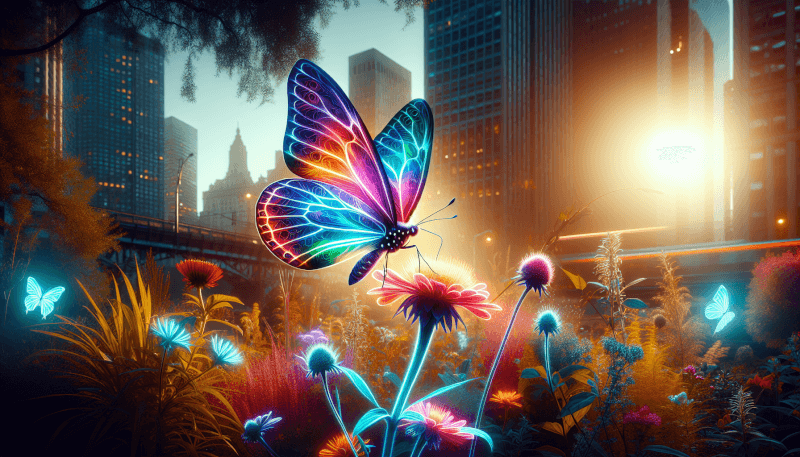Transforming your urban garden into a thriving habitat for wildlife is not only rewarding, but also beneficial for the environment. By incorporating a few simple steps, you can attract diverse species of birds, butterflies, and other fascinating creatures right into your backyard. From selecting native plants to providing water sources and shelter, this article will guide you through the process of creating a wildlife-friendly urban garden that will bring joy and excitement to both you and the creatures that call it home.

Choosing Native Plants
Benefits of native plants
Choosing native plants for your urban garden is an excellent way to support local ecosystems and attract wildlife. Native plants have evolved alongside local wildlife, providing essential food and habitat for birds, butterflies, bees, and other pollinators. By choosing native plants, you are creating a natural environment that is familiar to these creatures, promoting biodiversity and the overall health of your garden.
Researching native plants for your area
Before selecting native plants for your urban garden, it is crucial to research which species are best suited for your area. Different regions have unique climates, soil types, and sunlight conditions, which will determine which native plants thrive in your garden. Local nurseries, botanical gardens, and online resources can provide valuable information on native plants that are suitable for your specific location. Consider factors such as bloom time, water requirements, and the types of wildlife they attract when making your selections. With a little research, you can choose the perfect native plants that will flourish in your urban garden.
Creating Diversity
Mixing plant species
Adding a variety of plant species to your urban garden is key to creating a diverse and wildlife-friendly environment. When choosing plants, opt for a mix of trees, shrubs, flowers, and grasses to provide different layers and habitats for wildlife. By mixing plant species, you ensure a continuous supply of nectar, pollen, berries, and seeds throughout the year. This diversity will attract a wide array of birds, butterflies, and other wildlife to your garden.
Growing plants of different heights
In addition to mixing plant species, it is essential to select plants of varying heights for your urban garden. Taller trees and shrubs serve as shelter and nesting sites for birds, while shorter plants provide cover and foraging opportunities for smaller creatures. By incorporating a range of heights, you create a multi-dimensional landscape that can meet the needs of different wildlife species. Consider including climbers, groundcovers, and mid-height plants to maximize the diversity of your garden’s vegetation.
Including flowering plants
Flowering plants play a crucial role in attracting pollinators such as bees and butterflies to your urban garden. These vibrant and colorful plants provide a source of nectar and pollen, essential for the survival of many insects and birds. Choose a variety of flowering plants that bloom at different times throughout the year to ensure a steady food supply for pollinators. Native wildflowers, such as coneflowers, asters, and milkweed, are particularly beneficial as they are adapted to local ecosystems and support a wide range of wildlife.

Providing Water Sources
Installing a birdbath
Water is essential for both drinking and bathing for many species of birds. By installing a birdbath in your urban garden, you create a much-needed water source for these feathered friends. Choose a shallow birdbath with a gradual slope so that birds can safely enter and exit the water. Regularly clean and replenish the water to ensure it remains fresh and inviting. Place the birdbath in an open area with nearby perching spots, allowing birds to keep an eye out for potential predators while enjoying a refreshing dip.
Implementing a water feature
Adding a water feature, such as a small pond or waterfall, can greatly enhance the biodiversity of your urban garden. Water features not only provide drinking water for wildlife but also create habitats for aquatic insects, frogs, and even small fish. Consider incorporating aquatic plants such as lilies or water hyacinths to add further ecological value. Ensure that any water feature is shallow and has gradual slopes to prevent animals from becoming trapped. A well-designed water feature will attract a multitude of creatures and create a tranquil oasis within your urban garden.
Building Nesting Habitats
Installing birdhouses
Birdhouses provide a safe and cozy nesting place for a variety of bird species, especially those that lack suitable natural cavities for nesting. Choose birdhouses that are appropriately sized for the species you wish to attract, with entrance holes tailored to their needs. Position the birdhouses at the correct height and orientation, preferably facing away from prevailing winds and direct sunlight. Regularly inspect and clean the birdhouses to ensure they remain a suitable habitat for nesting birds. By installing birdhouses, you not only provide shelter but also the opportunity for birdwatchers to observe the nesting behaviors of these fascinating creatures.
Building a bee hotel
To support the essential work of pollinators, consider building a bee hotel in your urban garden. Bee hotels consist of nesting tubes or cavities that mimic the natural habitats of solitary bees, including mason bees and leafcutter bees. These bees are not aggressive and greatly contribute to pollination. Place the bee hotel in a sunny and sheltered location to attract a diverse population of solitary bees. Provide a variety of cavity sizes and materials to accommodate different species’ preferences. By offering a safe nesting habitat for bees, you are actively promoting pollination and the overall health of your urban garden.

Including Wildlife-Friendly Structures
Adding woodpiles or log piles
Woodpiles or log piles are excellent additions to an urban garden as they provide shelter and nesting sites for various wildlife, including insects, reptiles, and small mammals. These structures offer hiding places, protection from predators, and a valuable food source for species such as beetles and wood-boring insects. When constructing a woodpile or log pile, use untreated wood and arrange it in a secure and stable manner, with gaps and crevices for animals to access. Be mindful not to disturb these structures, as they may be home to a range of beneficial wildlife.
Installing rockeries or stone piles
Rockeries or stone piles can provide ideal habitats for many species of insects, reptiles, and amphibians. These structures provide heat insulation, shelter from extreme weather conditions, and a refuge for small creatures seeking protection. When designing a rockery or stone pile, use a variety of sizes and shapes to create a diverse range of microhabitats. Be cautious when moving or rearranging rocks, as there may be resident animals seeking shelter. By incorporating rockeries or stone piles into your urban garden, you create additional homes for a variety of wildlife.
Avoiding Chemicals
Using organic or natural pesticides
To maintain a wildlife-friendly urban garden, it is crucial to avoid the use of chemical pesticides. Instead, opt for organic or natural alternatives to control pests and diseases. Organic options, such as neem oil, insecticidal soaps, and biological controls, target specific pests without harming beneficial insects. By avoiding chemical pesticides, you protect pollinators and other wildlife from toxic substances while promoting a healthier ecosystem in your garden.
Avoiding chemical fertilizers
In addition to pesticides, it is essential to avoid the use of chemical fertilizers in your urban garden. Instead, opt for organic fertilizers, such as compost or well-decomposed manure, which enrich the soil naturally. Organic fertilizers promote healthy plant growth without causing harm to soil organisms or leaching harmful chemicals into water sources. By avoiding chemical fertilizers, you maintain a safer and more sustainable environment for wildlife in your urban garden.
Integrating Sustainable Practices
Collecting and reusing rainwater
Sustainable water management is key to a wildlife-friendly urban garden. Consider collecting rainwater in barrels or cisterns to use for watering your plants. This practice reduces the demand for tap water, which may contain chlorine or other chemicals that can harm wildlife. Use this collected rainwater to irrigate your garden during dry periods, ensuring your plants and the wildlife that rely on them have a consistent water supply.
Implementing composting
Composting is an effective and sustainable way to manage organic waste in your urban garden. By composting kitchen scraps, yard waste, and leaves, you create nutrient-rich compost that can be used to enrich the soil. Healthy soil is essential for the growth of native plants and provides vital habitat for beneficial organisms. Composting not only reduces waste and landfill contributions but also maintains a healthy ecosystem in your urban garden.
Creating Sheltered Areas
Planting shrubs or hedgerows
Shrubs and hedgerows are valuable additions to a wildlife-friendly urban garden as they provide shelter, nesting sites, and food sources for many species. Plant a variety of native shrubs that offer different heights and densities to accommodate various wildlife needs. Dense shrubs, such as hawthorn or elderberry, provide excellent cover for birds and small mammals, while flowering shrubs attract pollinators. By planting shrubs or hedgerows, you create a natural and protective environment that encourages wildlife to flourish.
Building a trellis or pergola
Building a trellis or pergola in your urban garden not only adds aesthetic value but also creates additional sheltered spaces for wildlife. Climbing plants, such as vines or ivy, can grow on these structures, providing cover and nesting opportunities for birds and insects. The overhead structure offers shade and protection from the elements, making it an attractive spot for various wildlife species. Ensure the trellis or pergola is sturdy and securely anchored to withstand wind and weather conditions.
Minimizing Artificial Lighting at Night
Using motion-sensor lights
To minimize the disturbance to nocturnal wildlife, consider installing motion-sensor lights in your urban garden. These lights only activate when they detect movement, helping to reduce light pollution and unnecessary energy consumption. By using motion-sensor lights, you provide enough illumination for safety and security concerns while minimizing the impact on wildlife.
Implementing baffles or shields on existing lights
If you already have lights in your urban garden, consider implementing baffles or shields to direct and minimize the light emitted. Baffles or shields can be installed on existing light fixtures to reduce light pollution and prevent light from shining upward or sideways. This ensures that the lighting remains focused on the intended area and reduces its impact on nocturnal wildlife.
Ensuring Safe Passage for Wildlife
Creating wildlife corridors
To ensure safe passage for wildlife between different habitats, create wildlife corridors in your urban garden. These corridors act as pathways for animals to move between green spaces, allowing them to access food, water, and shelter. By strategically planting native trees and shrubs, you can create linked habitats that enable wildlife to navigate urban environments more easily. Wildlife corridors help maintain genetic diversity and prevent species isolation, making them an essential aspect of a wildlife-friendly garden.
Removing physical barriers
Identify and remove any physical barriers that may hinder wildlife movement in your urban garden. These barriers may include fences, walls, or other obstacles that restrict access to vital resources or prevent animals from moving freely. By removing or modifying these barriers, you create a more inclusive environment that allows wildlife to explore and utilize the full extent of your garden and neighboring green spaces.
Creating a wildlife-friendly urban garden requires a thoughtful approach and a genuine commitment to promoting biodiversity. By choosing native plants, creating diverse habitats, providing water sources and nesting habitats, incorporating wildlife-friendly structures, avoiding chemicals, integrating sustainable practices, creating sheltered areas, minimizing artificial lighting at night, and ensuring safe passage for wildlife, you can transform your urban garden into a thriving ecosystem filled with the beauty and wonder of Mother Nature. Embrace these practices and welcome a multitude of creatures, big and small, to share in the joys of your garden oasis.


